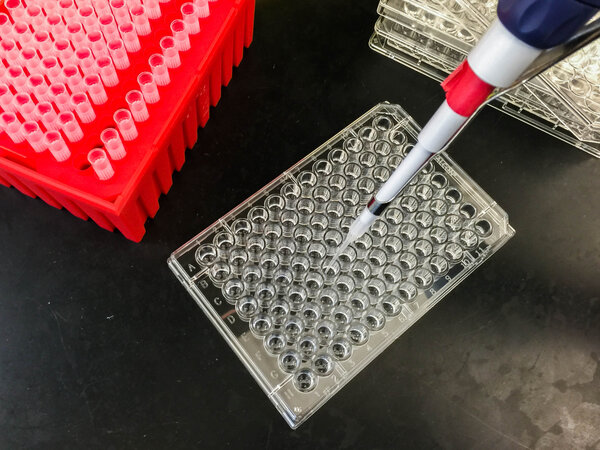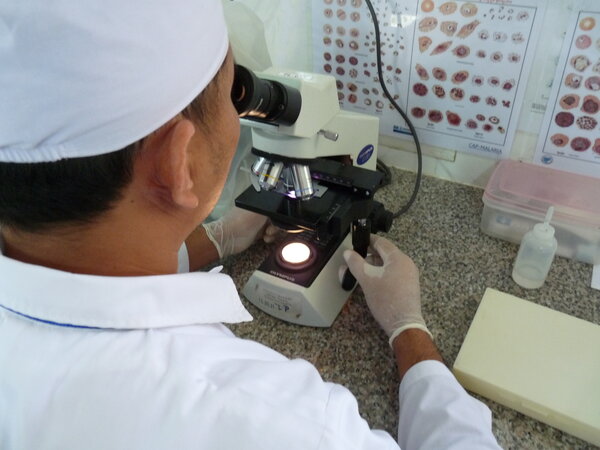Types of G6PD clinical diagnostic tests
Quantitative tests
Until recently, quantitative tests have been complex laboratory tests requiring good laboratory infrastructure. Recent years have seen the emergence of quantitative tests that can be used at the point of care in malaria endemic countries.4 These tests however have yet to receive WHO Prequalification.5
Spectrophotometric assay
- Spectrophotometry measures G6PD activity by measuring the formation of NADPH based on the difference in absorbance of the sample at 340 nm over time. This test is used in hospital laboratories.
- Typically, laboratories running this test will provide a quantitative G6PD activity value and a normal range. If the value lies within the range, the patient has normal G6PD activity and can be prescribed either tafenoquine or primaquine.
- The spectrophotometric assay is the gold standard for quantifying G6PD enzyme activity in red blood cells, providing a weighted average of the activity of the G6PD-deficient and G6PD-normal cells in any sample. Thus, it is used as a reference test against which to evaluate the performance of new point-of-care tests (both quantitative and qualitative).
- Note that results are affected by the concentration of haemoglobin in the blood sample – in anaemic subjects, or those with iron deficiency, G6PD values will be falsely high.
Point-of-care quantitative tests for G6PD deficiency
Recent years has seen the emergence of point-of-care test for G6PD deficiency, and it is anticipated the new products will also become available.1 Currently there are two products on the market:
STANDARD G6PD test (SD Biosensor)
- Measures G6PD activity and haemoglobin and provides a G6PD value normalized for haemoglobin concentration (U/g Hb)
- The test is designed for use at the point -of-care and is of modest complexity.
G6PD Biosensor (AccessBio)
- Measures G6PD activity, requires a separate device to measure haemoglobin;
- The test is designed for use at the point -of-care and is of modest complexity.
Qualitative G6PD tests
Qualitative tests give a deficient/normal read out for G6PD deficiency. However, for each test, care should be taken to understand what ‘deficient’ and ‘normal’ mean. Currently available tests cannot reliably identify female heterozygotes with G6PD activity ≥30% of normal.
The sensitivity of the test will vary depending on the G6PD activity. Thus, a test may accurately identify a G6PD hemizygous male with a G6PD activity of <30% of normal as ‘G6DP deficient’, whereas a heterozygous female with G6PD enzyme activity of 50% of normal could be identified as ‘G6PD normal,’ when in fact this individual would be at risk of severe haemolysis from 8-aminoquinoline treatment.
Fluorescent spot test
- The fluorescent spot test (FST) is based on the natural fluorescence of NADPH (nicotinamide adenine dinucleotide phosphate) under ultraviolet light. G6PD produces NADPH so G6PD-normal samples produce a bright green fluorescent spot and G6PD-deficient samples do not.1
- The test is simple and inexpensive, and is robust for use in different settings with a read out within 30 min. However, a cold chain is needed for reagents, electricity and training for the interpretation of results.
Lateral flow rapid diagnostic tests (RDTS)
- Qualitative tests have been made on the same diagnostic platform as malaria rapid diagnostic tests. These are operationally very well suited for malaria case management and resources are available for training of healthcare staff.2
- Two tests are available (Binax Now® G6PD and Carestart G6PD™). Both are easy to use with read outs within 15 mins. Binax Now® cannot be used above 25°C and so cannot be used in P. vivax endemic areas. Carestart G6PD™ is suitable for use at temperatures 18–32°C.
- Both these tests can reliably identify G6PD-deficient samples with enzyme activities <30% of normal.3
- Limitations of these test are: they do not have control lines, and they cannot adjust for temperatures higher than 25-32°C.

